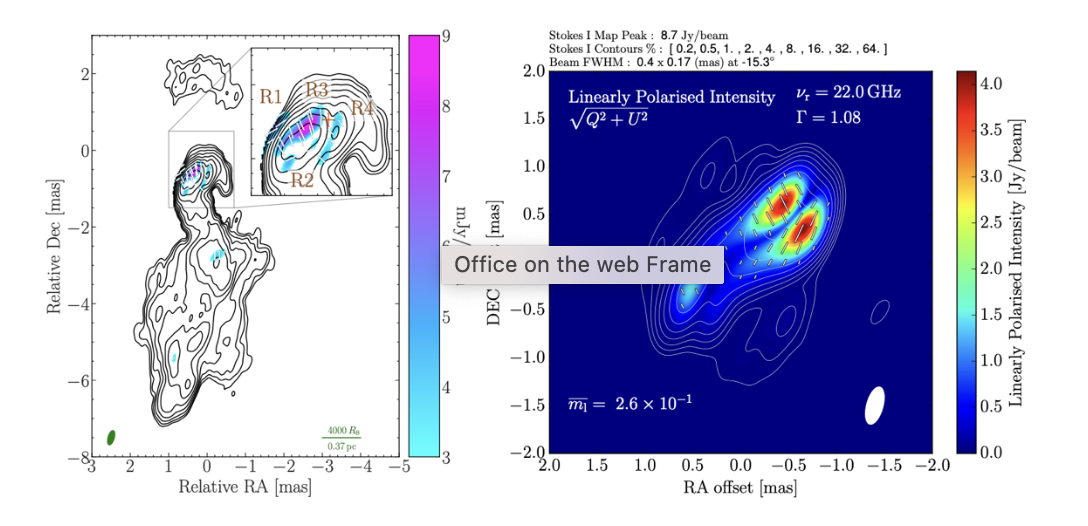
Revealing a magnetic field’s morphology through polarised light
Georgios Filippos Paraschos
Directly resolving the shadow of a supermassive black hole (SMBH) and the surrounding medium of the host galaxy has only been possible for a particular set of radio sources (EHTC et al., 2019; Event Horizon Telescope Collaboration et al., 2021). For all other sources, polarimetric observations are key for studying energy extraction from black holes (Paraschos et al., 2022) and for revealing magnetic field structures in jets, providing critical insights into their formation mechanism. SMBHs are thought to be capable of launching jets, both via its ergosphere (Blandford and Znajek, 1977, BZ model) and via its accretion disc (Blandford and Payne, 1982, BP model). A stratified combination of the two mechanisms can result in a spine-sheath type of flow (e.g. Hirotani et al., 2024).
The radio source 3C 84, located at a luminosity distance of 78.9 Mpc in the Perseus galaxy cluster, is one of the nearest and brightest radio galaxies in the northern sky, and thus is a prime target to study jet formation (Paraschos et al., 2024). Its jet is characterised by limb brightening detected in total intensity (Nagai et al., 2014; Giovannini et al., 2018), reaching deep into the source’s sub-parsec-scale region. Polarisation has been detected mostly in the extended parsec-scale southern emission (e.g. Nagai et al., 2017); a polarisation signature in the core region of 3C 84 remained elusive.

Figure 1, Left: Total intensity (black contours) and linearly polarised (colour scale) observations of 3C 84 conducted with the EVN. Four distinctive regions can be identified in the core; R1 (corresponding to a possible collision site between the jet and ambient medium), R2 (associated with a spine), and R3 and R4 (comprising the surrounding sheath). The white lines correspond to the position angles of the electric field vectors (EVPAs). They are following the bulk jet flow in the spine and are perpendicular to it in the sheath. Right: RMHD simulation of the core region of 3C 84, assuming a toroidal magnetic field configuration. Both the EVPA orientations and the spine-sheath morphology are reproduced.
In our study we were able to leverage the superb sensitivity and (u, v) coverage of the European VLBI Network (EVN), augmented by additional antennas around the globe, to study the compact region of 3C 84 in polarised light in unprecedented detail. The left panel of Fig. 1 showcases our observation of 3C 84 at 22 GHz. Both the fast moving spine, as well as the surrounding sheath are revealed in polarised light, reaching deep into the compact region, as described in the figure’s caption. In order to identify the magnetic field configuration responsible for producing this spine-sheath geometry, we performed state-of-the-art hybrid fluid-particle relativistic magneto-hydrodynamic (RMHD) simulations using the PLUTO code and the included therein Lagrangian particle module (Mignone et al., 2007; Vaidya et al., 2018). In our simulations we explored toroidal, poloidal, and helical configurations and also varied the bulk Lorentz factor Γ (Kramer and MacDonald, 2021). As shown in the right panel of Fig. 1, a toroidal magnetic field configuration reproduces the observed linearly polarised flux density, as well as the orientation of the electric field vectors, for Γ ∼ 1.
Overall, our work reveals a limb brightened structure in the core region of 3C 84, prominently detected in both total intensity and linear polarisation. Utilising RMHD simulations we find that the observations are best reproduced by an underlying toroidal magnetic field, associated with a mildly relativistic flow speed. Our upcoming multi-frequency follow-up EVN observations of 3C 84 will provide spectral information to enhance our understanding of the physical conditions in its core region.
References:
R. D. Blandford and D. G. Payne, 1982, MNRAS, 199:883–903
R. D. Blandford and R. L. Znajek, 1977, MNRAS, 179:433–456
Event Horizon Telescope Collaboration 2019, ApJL, 875(1):L1
Event Horizon Telescope Collaboration 2021, ApJL, 910(1):L12
G. Giovannini, T. Savolainen, M. Orienti et al. 2018, NatAst, 2:472–477
K. Hirotani, H. Shang, R. Krasnopolsky et al. 2024, ApJ., 965(1):50
J. Kramer and N. R. MacDonald 2021, A&A, 656:A143
A. Mignone, G. Bodo, S. Massaglia et al. 2007, ApJS, 170(1):228–242
H. Nagai, T. Haga, G. Giovannini, A. et al. 2014, ApJ., 785(1):53
H. Nagai, Y. Fujita, M. Nakamura, et al. 2017, ApJ, 849(1):52
G. F. Paraschos, T. P. Krichbaum, J. Y. Kim,et al. 2022, A&A, 665:A1
G. F. Paraschos, J. Y. Kim, M. Wielgus, et al. 2024, A&A., 682:L3
B. Vaidya, A. Mignone, G. Bodoet al. 2018, ApJ, 865(2):144
More information: Paraschos, G. F. et al., 2024, A&A, 686, 5P
Contact: gfparaschos@mpifr.de